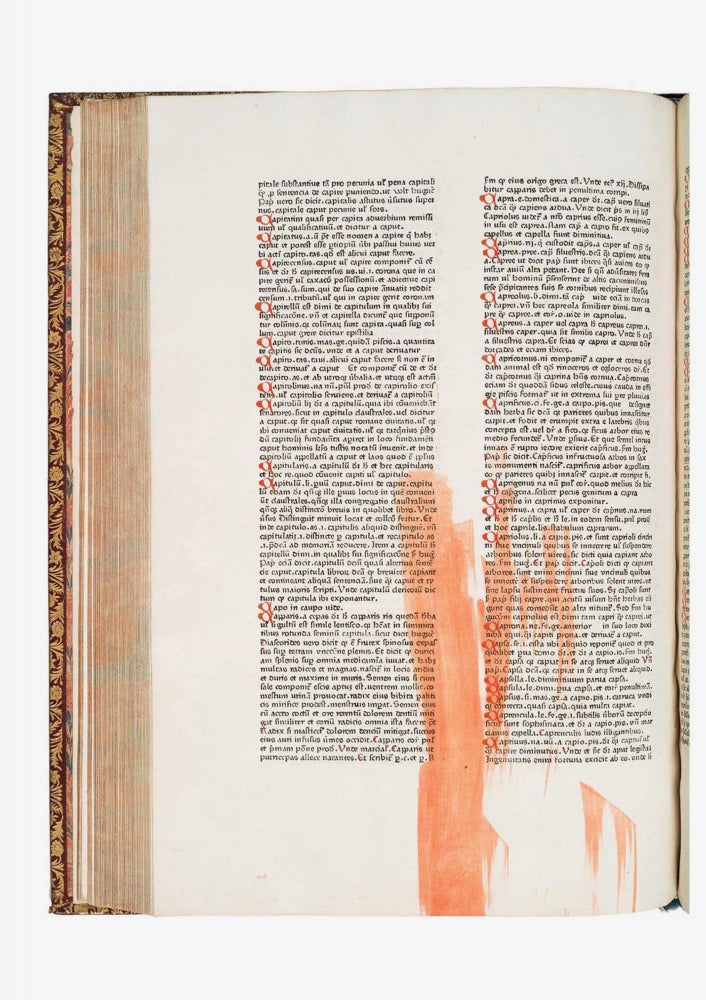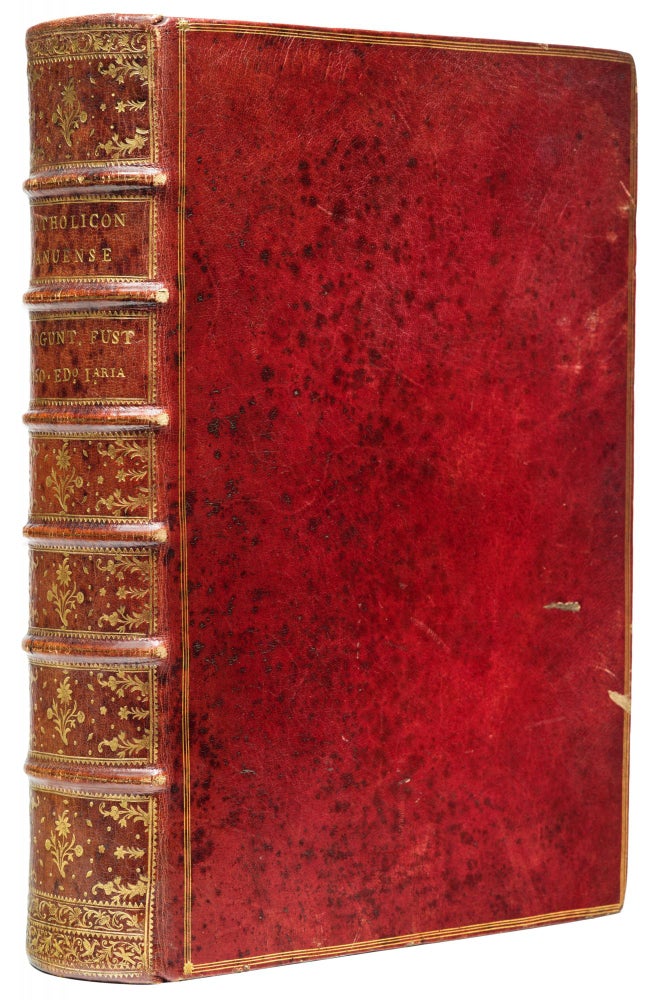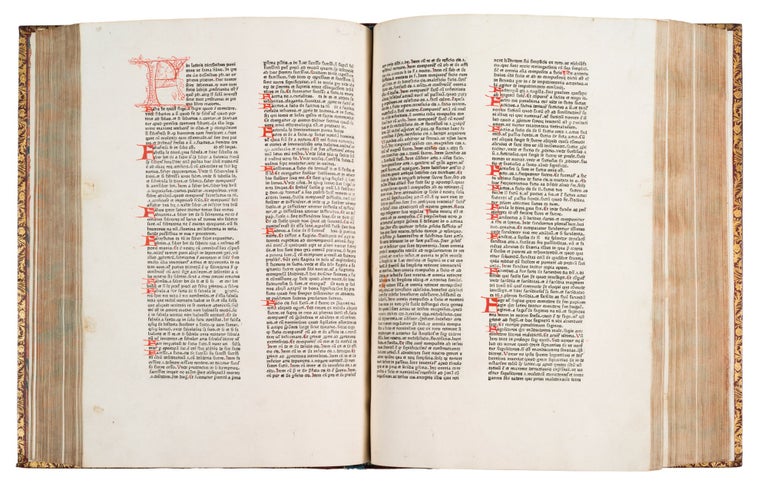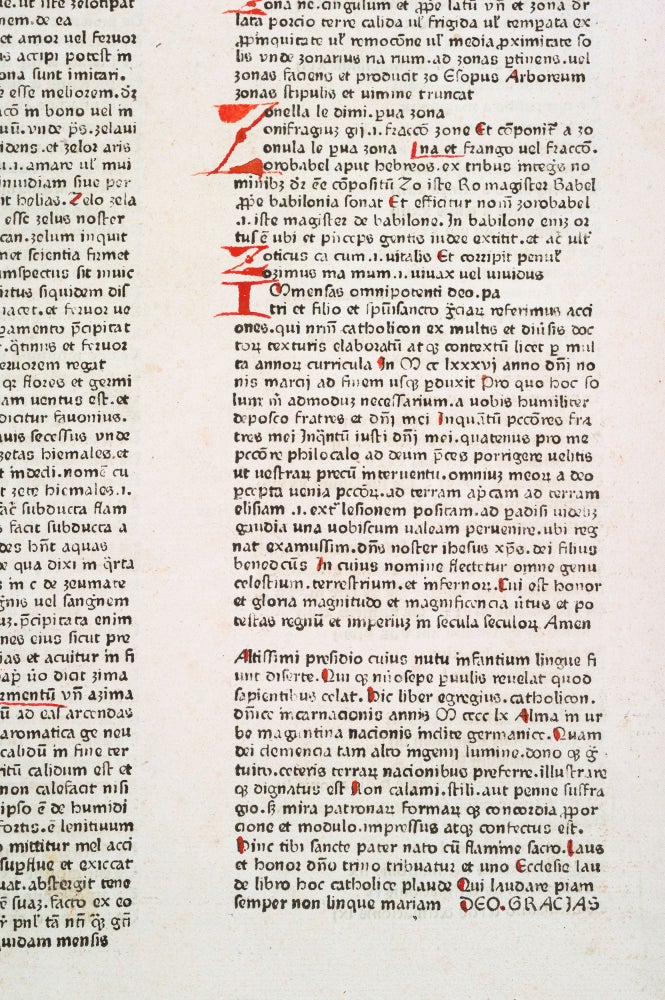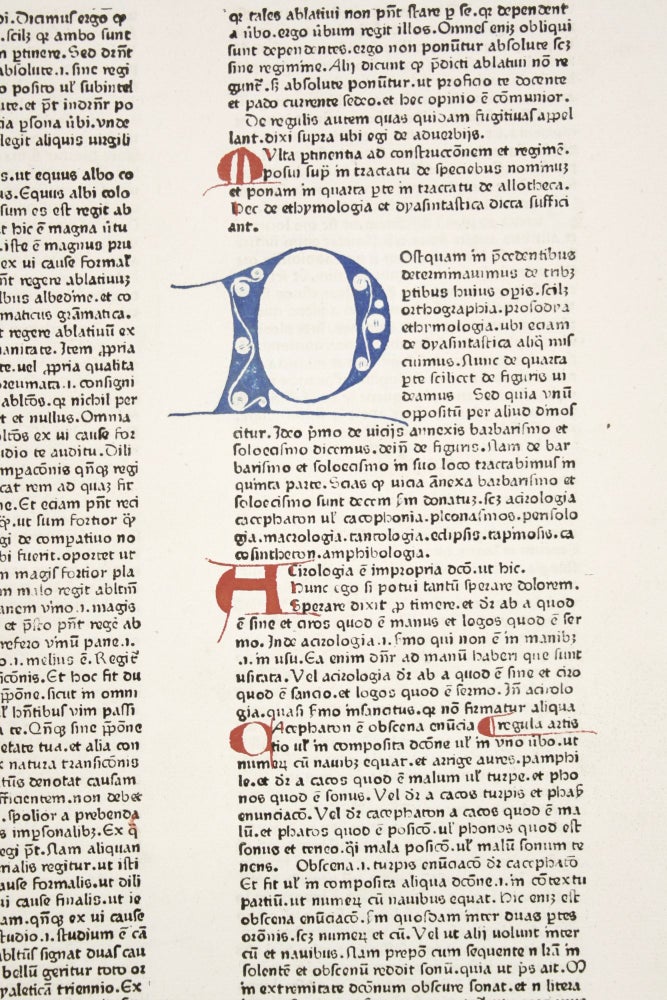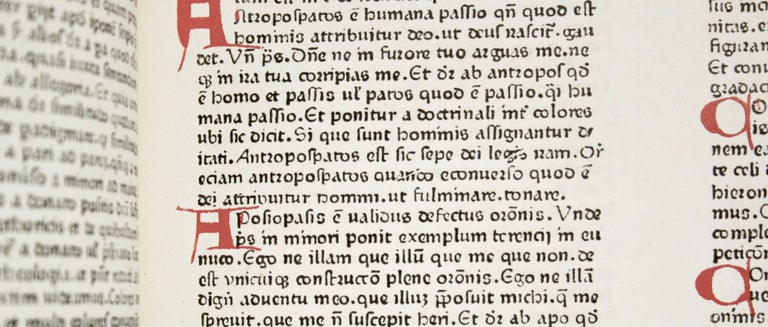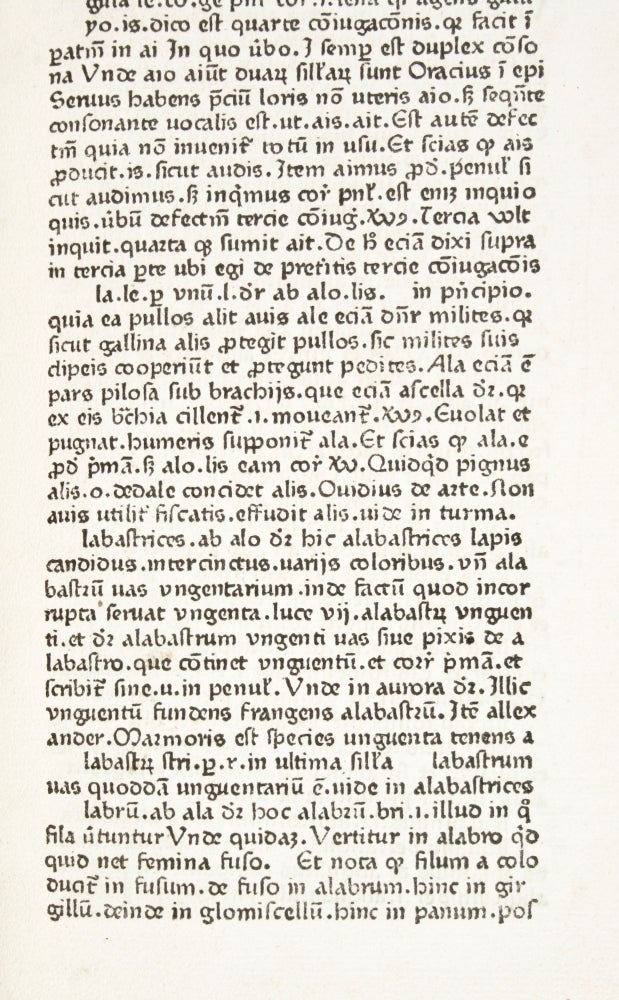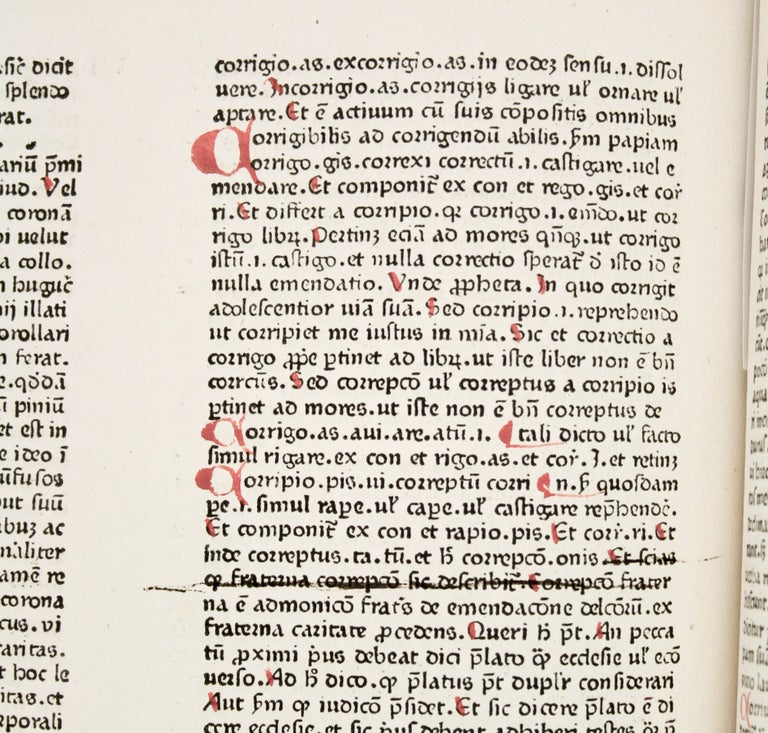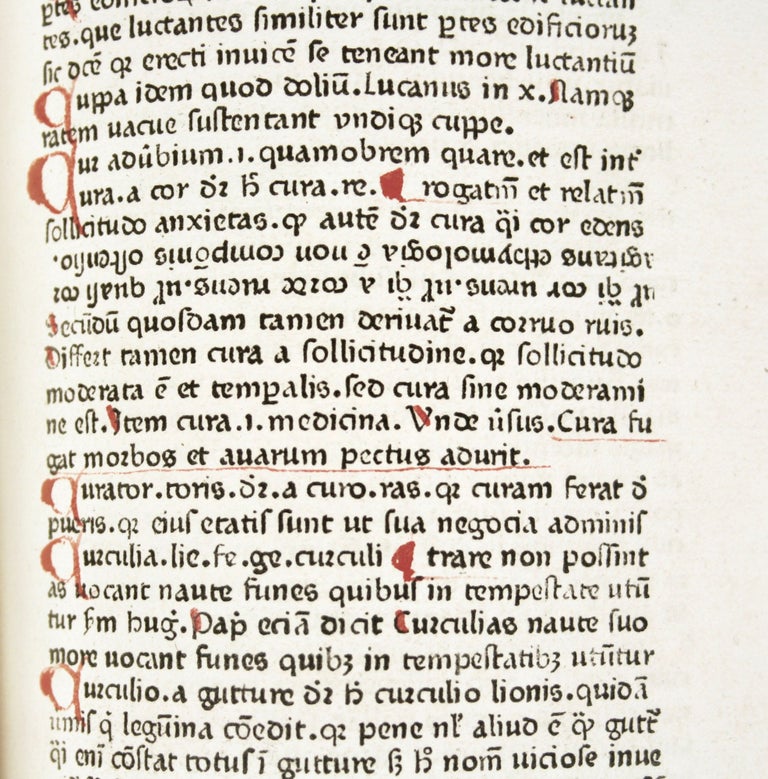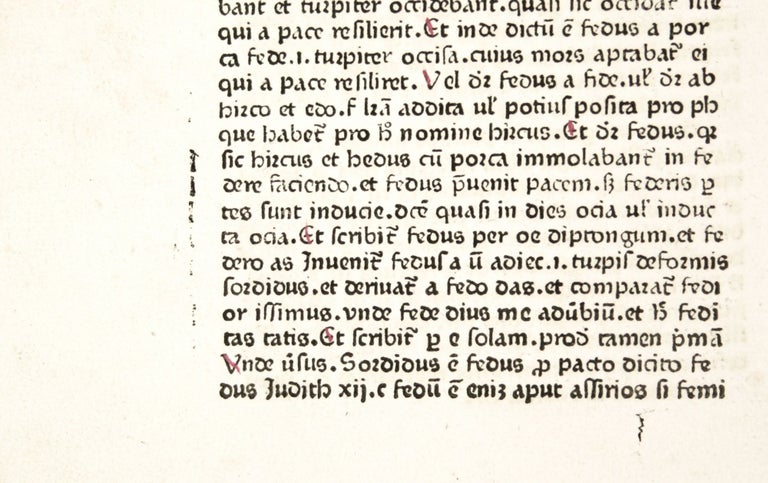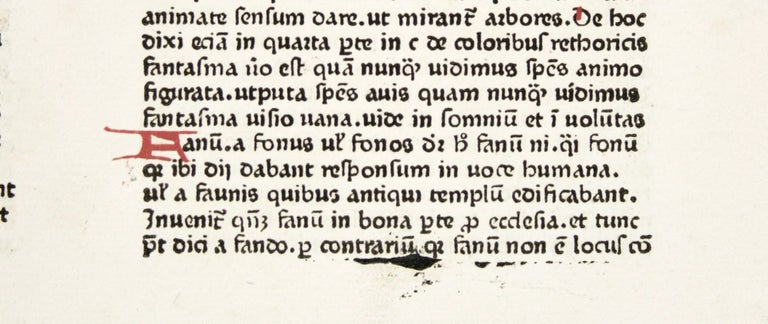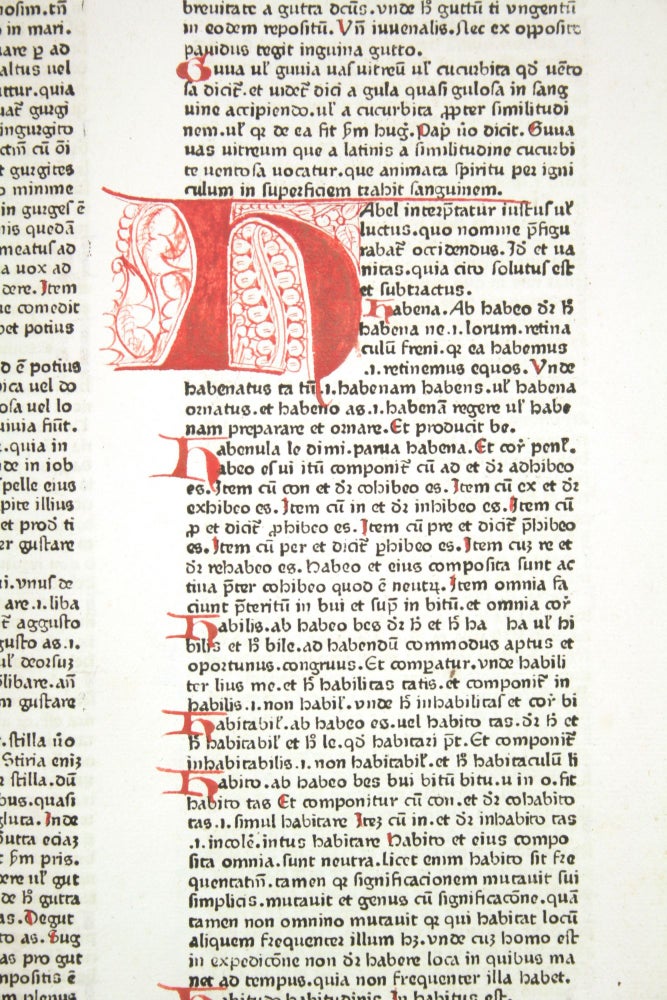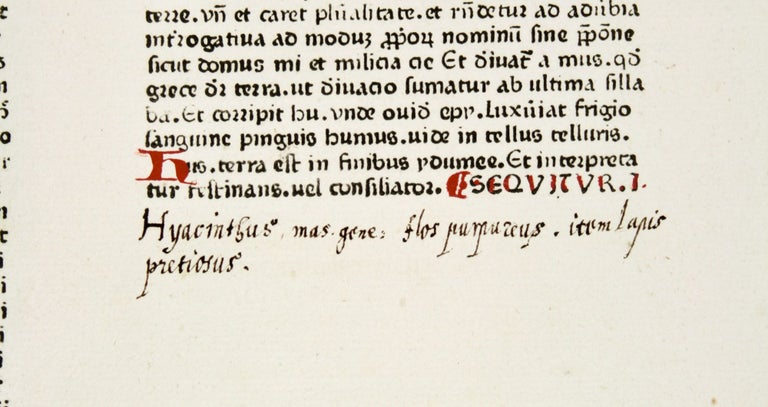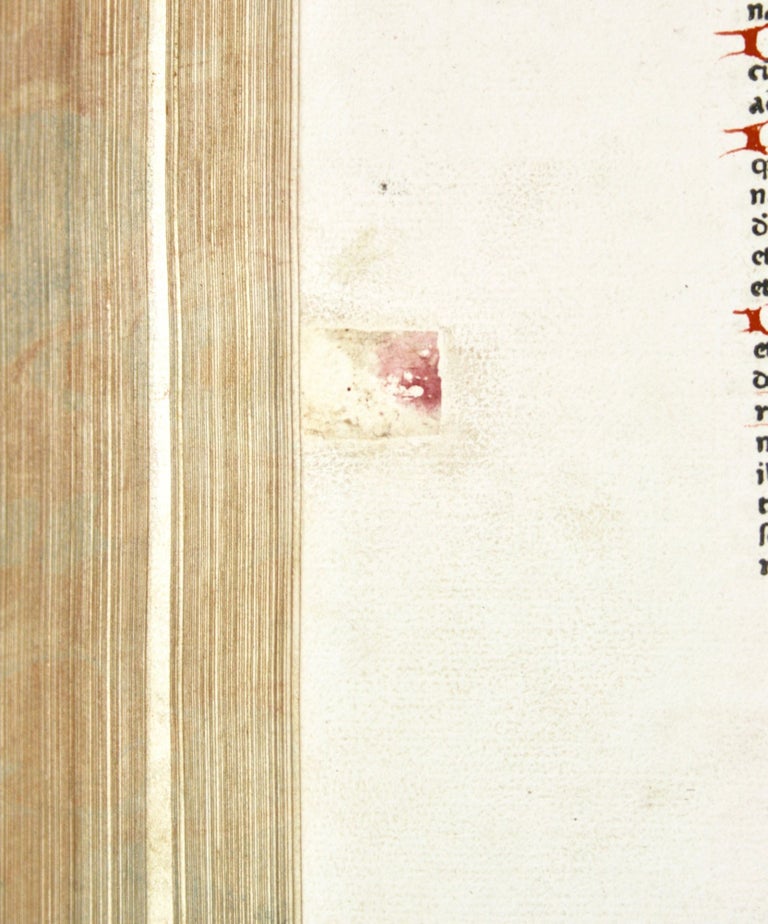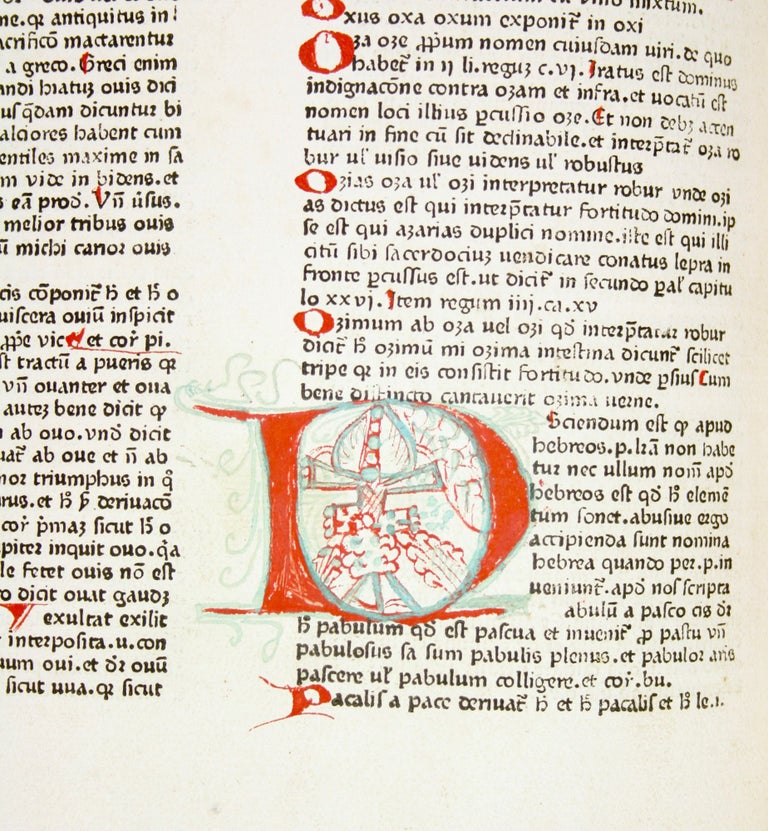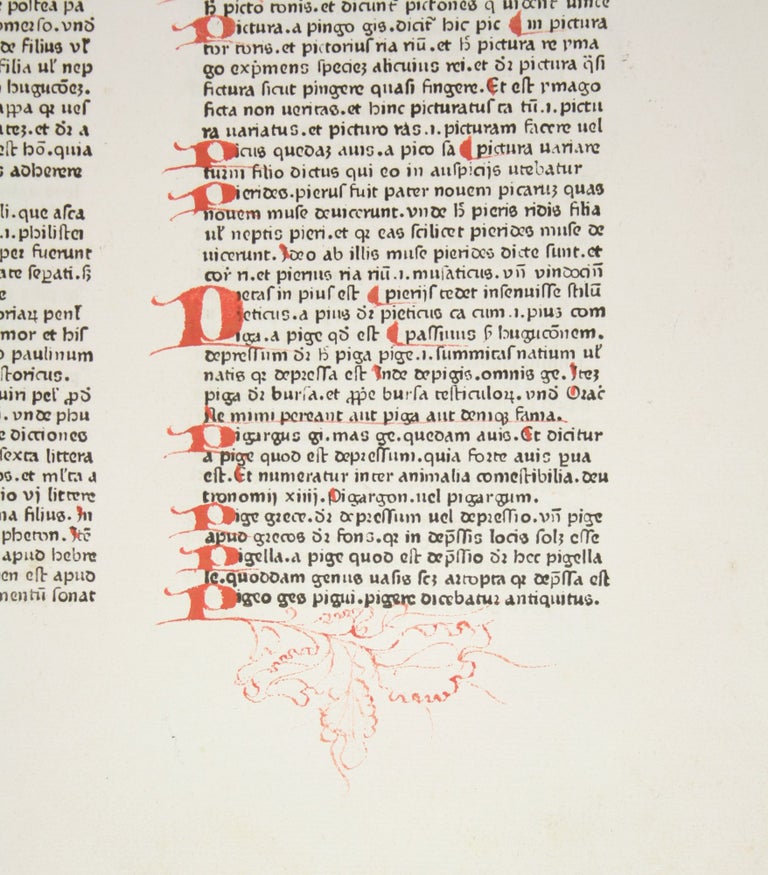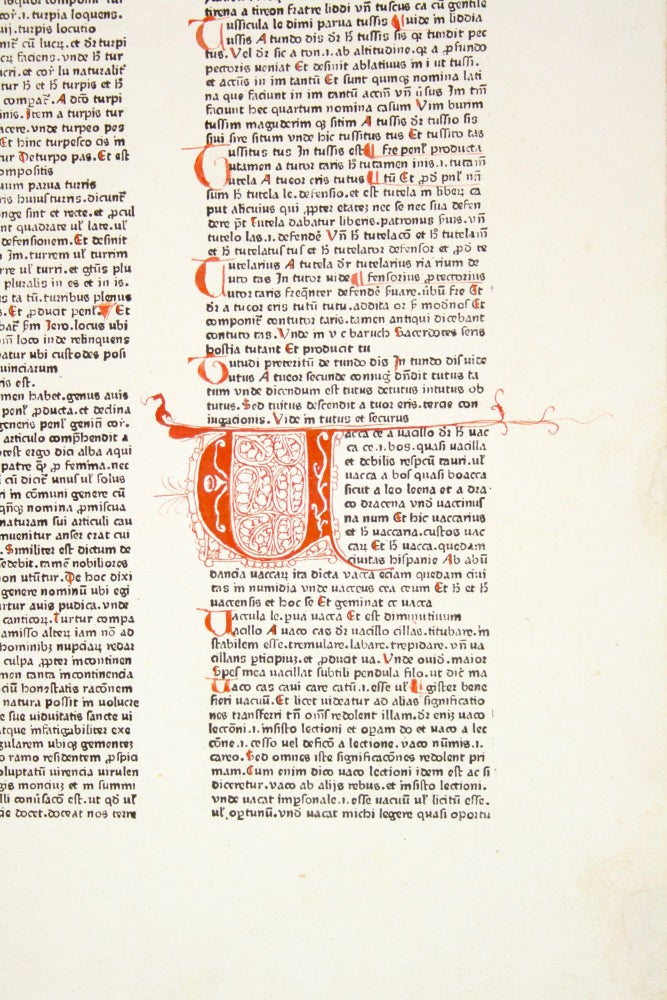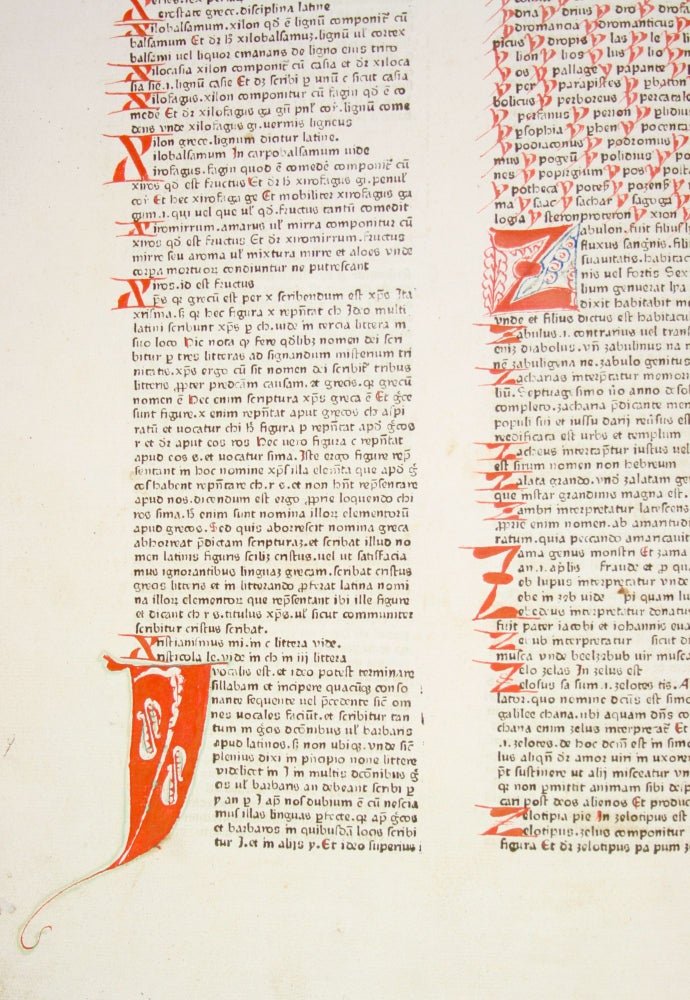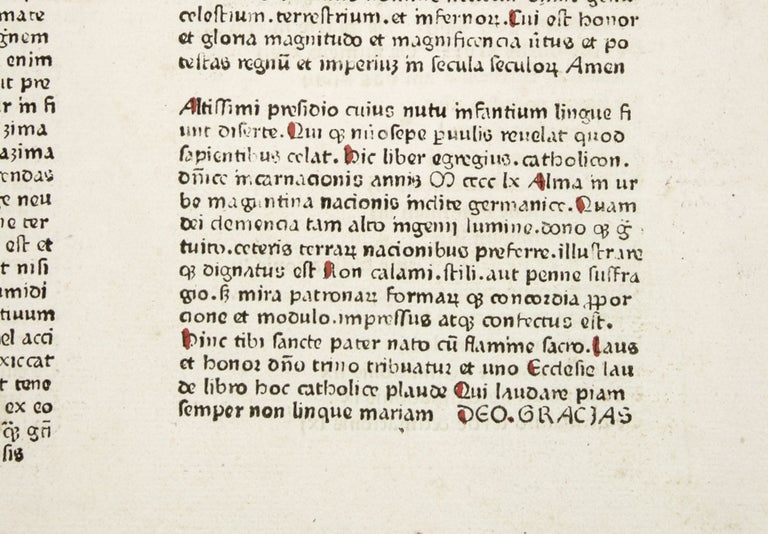Catholicon.
Mainz: [Peter Schoeffer], 1469.
Price: $600,000.00
Royal Folio: 385 x 270 mm. Collation: [1-610, 74].
SECOND IMPRESSION (of three) of the original edition, using the two-line printing slugs created by Gutenberg for the first printing.
Collation: [1-610, 74]: grammar, 1r incipit (P)rosodia quedam pars grammatice nuncupatur. Partes siquidem grammatice sunt quattuor (contractions resolved); [8-1910 204(4+1)]: dictionary A-H, 8/1r incipit (I)am divina potencia auxiliante supra determinavimus de quatuor particulis principalibus huius operis. Nunc restat ut de quinta parte, 20/4+1r incipit manus cum suis derivativis, verso blank; [21-3810 394]: dictionary I-Z, 21/1r incipit (I) est imperativus de eo is it, 39/3r colophon Altissimi presidio cuius nutu infantium lingue fiunt diserte... Hic liber egregius, catholicon, dominice incarnacionis annis M cccc 1x Alma in urbe maguntina nacionis inclite germanice ... Non calami, stili, aut penne suffragio, sed mira patronarum formarum que concordia proporcione et modulo, impressus atque confectus est (followed by four lines of verse), 39/3v rubrics table incipit de ortographia 1, 39/4v blank.
373 leaves, no signature marks. Collation by quires: (1)-(6)10, (7)4, (8)-(19)10, (20)4+1, (21)-(38)10, (39)4. Single paper-stock from Basel, watermarked with the seal of the Galliziani family, in third state. Gothic type 83mm, secondary casting of paired lines (indissoluble "slugs"). Double column, 66 lines (33 line-pairs), 8 pinholes to the sheet preserved.
The first book to name its place of printing, the Catholicon is also the first book to refer in print to the invention of moveable metal type:
"With the help of Omnipotent God, at Whose very nod the tongues of infants are made eloquent, and Who often reveals to the humble what He withholds from the wise - this excellent book, Catholicon, has been printed in the goodly city of Mainz, in the glorious German nation . . ., and it has been brought to completion in the year of our Lord's incarnation, 1460 - not by means of reed, stylus, or quill, but with the miraculous concurrence of punches and types cast in moulds . . ."
DECORATION by a contemporary Dutch or Westphalian artist: 12-line penwork initial P (fo. 1r) in blue and white, with green and red infill and red surround extending down the entire inner margin, 9-line penwork initial P on the same page in red, with violet and green infill and surround; 4-13-line initials in blue and white, or in red with penwork surround, 1-3-line red lombards, paragraph-marks and capital-strokes, initial L on 24/1v omitted and later supplied in black ink, rubrication entirely omitted from 13/10r and 18/7r. (Extreme inner margin of first leaf strengthened, small tear in its lower blank margin mended, recto lightly soiled; minor repair to extreme margins or corners of 10 other leaves not affecting text, tiny hole in 16/4 affecting three letters; rubricator's stain on 11/6v, small stains on 8/3-9, 22/8v and 33/10v.)
BINDING: mid-18th-century French gold-tooled red morocco over pasteboard, triple fillets on sides, spine decorated in compartments with floral ornament and lettered, marbled endpapers, probably bound for the Duke of La Vallière.
Provenance: quire signatures and occasional marginalia in a 16th-century hand -- Polling, Augustinian canons regular, paper copy (DeRicci, Mayence 71), to Duc de la Valliere, by exchange for 5 early manuscripts approved by Polling’s Prior, Franz Töpsl [see references at end of this description] -- Louis-César de la Baume-le-Blanc, Duc de La Vallière (rebinding, 1767 auction of duplicates, lot 2287, fr. 474) -- George Hibbert (1829 Evans sale, lot 812, £36-4-6 to Payne and Foss) -- Beriah Botfield, purchased for £45 (pencil inscription, P.& F. Acquisitions p.15). La Vallière also owned two other paper copies: De R 90.53 (third impression, now Austrian National Library) and De R 90.72 (imperfect, "disparu"), as well as a vellum impression De R 90.1 (now British Library IC.301).
No cancellation is known in the second impression. The Hibbert-Botfield copy shows the accident of imposition on 14/7 col. a (line-pair 35/36 upside down) and the damage to 6/10 col. a (line-pair 41/42), but line-pair 53/54 on 8/7 col. a is undamaged. The three two-line slugs from the colophon blind-impressed as bearer type on 20/4+1r only partly visible. A few copies of Gutenberg's Catholicon remain in private hands, but all three impressions are EXTREMELY RARE on the market. This is one of the La Valliere paper copies; he also owned two others: De R 90.53 (third impression, now Austrian National Library) and De R 90.72 (imperfect, "disparu"), as well as a vellum impression De R 90.1 (now British Library IC.301). .
The book was first published at Mainz in 1460, most probably by the inventor of typography himself, Johann Gutenberg. (The next editions were printed by Günther Zainer in Augsburg on 30th April 1469 [GW 3183] and Mentelin and Rusch in Strassburg c.1475 [GW 3184-5] respectively.) In 1905 Gottfried Zedler in his monograph on the Mainz Catholicon demonstrated three quite separate issues of the edition, printed on distinct presses: on vellum or Bull's-Head paper (1), on Galliziani paper (2), on Tower and Crown-watermarked papers (3). Similarly, two separate issues have been recorded of two chancery half-sheet productions in the same type from the Catholicon Press: St. Thomas Aquinas' Summa de articulis fidei (C 562 and H 1425) and Matthaeus de Cracovia's Dialogus rationis et conscientiae (H 5803); for copies of the second impression of the latter sold at auction, see Christie's New York catalogues of the Friedlaender Collection (23 April 2001, lot 81) and the Doheny Collection (14 December 2001, lot 28).
Theo Gerardy in Gutenberg Jahrbuch articles of 1971, 1973 and 1980 showed that the Galliziani and Tower/Crown paper stocks in the Catholicon did not exist in 1460 and therefore suggested a date in the late 1460s for the edition as a whole. This dating of all three issues to c. 1469 was later taken up by Lotte Hellinga, who added numerous details and arguments to support it in a wide-ranging investigation of typographical evidence in the Catholicon and textual evidence in the 4° Aquinas (see Gutenberg Jahrbuch1989, 1990, 1991, Bulletin du Bibliophile 1991, The Book Collector 1992, Archiv für Geschichte des Buchwesens 1993). Eva Ziesche and Dierk Schnitger in Archiv für Geschichte des Buchwesens (1980) further analysed the states of the papers, their chronology and appearance in other dated books. They accepted the printed date (1460) for the vellum/Bull's Head Catholicon, dated the Galliziani Catholicon to the late 1460s and the Tower/Crown Catholicon to the early 1470s; they concluded that these represented three different editions, ignoring the long-established fact that all three derive from the same setting of type.
Paul Needham was the first since Zedler to re-examine all bibliographical aspects of the Catholicon Press productions. When he first published his findings in The Papers of the Bibliographical Society of America (1982), the article was generally received as a classic of analytical bibliography; and it is not exaggerating to say that it changed the methods of other incunabulists and added to the perception of Gutenberg's genius. Over the next ten years he expanded considerably on his work and replied at length to objections raised to his conclusions (see his articles in Wolfenbütteler Notizen zur Buchgeschichte1988, Gutenberg Jahrbuch 1990 and 1991, Bulletin du Bibliophile 1992). The Catholicon was not printed with movable type. After inventing printing from movable type, Gutenberg went on to meet "the challenge of permanently fixing typographical compositions," an early form of stereotyping or linotype setting. As composition in type of the Catholicon progressed, a secondary casting was made in units of paired lines or "slugs" in order to allow future reprinting without the expense of resetting the text. All typographical accidents and variations between the three impressions -- as well as irregularities within each impression -- occur to line-pairs (even-numbered line always following its odd-numbered predecessor). This involves lines of text imposed upside down or in the wrong order, replacement of damaged type, presence of bearer type from widely separated sections, etc. The late Martin Boghardt's discoveries of cancellation and replacement of leaves in the first and third impressions of the Catholicon consistently shows correction and resetting of double lines, never entire columns or pages (see Wolfenbütteler Notizen zur Buchgeschichte 1988 and Bibliothek und Wissenschaft 1996). This typographical explanation has apparently withstood all bibliographical tests. (How exactly the secondary or linotype casting was realized is a matter of speculation, certainly as long as the casting techniques of movable-type founts in the first two decades of printing remain a mystery.) Copies of all three impressions survive with dated inscriptions, confirming their proposed dates of printing (the earliest in the 1460 first impression, none too early for the 1469 second and 1473 third impressions).
After printing the Catholicon, Thomas Aquinas' and Matthaeus de Cracovia's tracts in 1460 with his new method, Gutenberg also printed with the same type -- but in its movable form -- three broadside indulgences in 1461 (Einblattdrucke50), 1462 (Einblattdrucke 52) and 1464 (Leonhard Hoffmann in Zentralblatt für Bibliothekswesen 1979). He then falls silent and dies on 3rd February 1468. On the 26th of the same month Konrad Humery (c. 1405-c.1472), Mainz syndic and jurist, declares himself the owner of all Gutenberg's typographical materials. A year later Peter Schoeffer lists in his advertisement of books in stock the Catholicon, the Aquinas and the Matthaeus (see Wilhelm Velke in Veröffentlichungen der Gutenberg-Gesellschaft 1908). This reconnects Gutenberg and Schoeffer, who was the only printer left in Mainz by this date; Dr Humery will either have sold him the inventor's stock of "slugs" or commissioned from him the second impressions of the three works. At about the same time the Catholicon fount of movable type turns up in several editions printed at Eltvil by Nicolaus Bechtermüntze. The third impression of Catholicon was no doubt also printed by Schoeffer, but on his own account as Humery had died by that time.
The Dominican Johannes Balbus finished the "Catholicon", which became the standard Latin dictionary of the later Middle Ages, on 7th March 1286.
HC *2254; GW 3182(3); BMC I, 39 (IC. 303); Goff B-20; CIBN B-13 (II); De Ricci, Mayence 90.97= ? 90.71 (both "exemplaires disparus"). BMC assigns letters to the collation: a-f10, g4, h-t10, v4+1, A-S10, T4.


